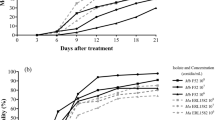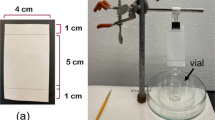Abstract
In the field in south-central Sweden, we tested by randomised, standardised methodology the potential anti-tick repellent activity of two concentrations of MyggA® Natural spray (containing PMD) (4.2 and 3.2 g/m2) and one of RB86 (with 70% neem oil containing azadirachtin)(3 g/m2) to host seeking nymphs of Ixodes ricinus. Each substance was applied separately to 1 m2 cotton flannel cloths. Nymphal ticks on the cloths, pulled over the vegetation, were recorded at 10-m stops. Nymphal numbers recorded differed significantly between treated cloths [4.2 or 3.2 g MyggA® Natural spray/m2 and 3 g RB86/m2] and the untreated control (df = 3, χ2 = 112.74, P < 0.0001). Nymphal numbers also differed significantly among collectors (df = 3, χ2 = 15.80, P < 0.001). Repellency of treated cloths, i.e., 4.2 or 3.2 g MyggA® Natural spray/m2 and 3 g RB 86/m2 declined from day 0 (i.e. the day of impregnation) to day 3 after impregnation from 77 to 24%, 58 to 16% and 47 to 0.5%, respectively. This study suggests that all three treatments have significant repellent activities against I. ricinus nymphs.



Similar content being viewed by others
References
Abdel-Shafy S, Zayed AA (2002) In vitro acaricidal effect of plant extract of neem seed oil (Azadirachta indica) on egg, immature, and adult stages of Hyalomma anatolicum excavatum (Ixodoidea: Ixodidae). Vet Parasitol 106:89–96
Buescher MD, Rutledge LC, Wirtz RA (1982) Tests of commercial repellents on human skin against Aedes aegypti. Mosq News 42:428–433
Curtis CF, Lines JD, Lu B, Renz A (1991) Natural and synthetic repellents In: Curtis CF (ed) Control of disease vectors in the community. Wolfe, London, pp 75–92
Gardulf A, Wohlfart I, Gustafson R (2004) A prospective cross-over field trial shows protection of lemon Eucalyptus extract against tick bites. J Med Entomol 41:1064–1067
Jaenson TGT (1999) Fästingen Ixodes ricinus som sjukdomsöverförare i Skandinavien [The tick Ixodes ricinus as a vector of diseases in Scandinavia]. Växtskyddsnotiser 63:53–59
Jaenson TGT, Lindström A, Pålsson K (2003) Repellency of the mosquito repellent MyggA® (N,N-diethyl-3-methyl-benzamide) to the common tick Ixodes ricinus (L.)(Acari: Ixodidae) in the laboratory and field. Entomol Tidskr 124:245–251
Jaenson TGT, Garboui S, Pålsson K (2006) Repellency of oils of lemon eucalyptus (Corymbia citriodora), geranium (Pelargonium graveolens) and lavender (Lavandula angustifolium), and the mosquito repellent MyggA Natural® to the common tick Ixodes ricinus (L.) (Acari: Ixodidae) in the laboratory and field. J Med Entomol 43:731–736
Jaenson TGT, Pålsson K, Borg-Karlsson A-K (2005) Evaluation of extracts and oils of tick repellent plants from Sweden. Med Vet Entomol 19:345–352
Malonza MM, Dipeolu OO, Amoo AO, Hassan SM (1992) Laboratory and field observations on anti-tick properties of the plant Gynandropsis gynandra (L.). Brit Vet Parasitol 42:123–136
Mejlon HA, Jaenson TGT (1993) Seasonal prevalence of Borrelia burgdorferi (Acari: Ixodidae) in Ixodes ricinus (Acari: Ixodidae) in different vegetation types in Sweden. Scand J Inf Dis 25:449–456
Meyer JA, Hunter JS III (1991) Residual activity of microencapsulated permethrin against stable flies on lactating diary cows. Med Vet Entomol 5:359–362
Mulla M, Su T (1999) Activity and biological effects of neem products against arthropods of medical and veterinary importance. J Am Mosq Control Assoc 15:133–152
Ndumu PA, George JBD, Choudhury MK (1999) Toxicity of neem seed oil (Azadirachta indica) against the larvae of Amblyomma variegatum a three-host tick in cattle. Phytother Res 13:532–534
Ndungu M, Lwande W, Hassanali A, Moreka L, Chabra SC (1995) Cleome monophylla essential oil and its constituents as tick (Rhipicephalus appendiculatus) and maize weevil (Sitophilus zeamais) repellents. Entomol Exp Applic 76:217–222
SCI (Swedish Chemicals Inspectorate/Kemikalieinspektionen/KEMI) (2004) MK 19- mikroinkapslat myggmedel. [MK19 - microencapsulated mosquito repellent, In Swedish] Diary number: KEMI F-2494-427-04
Sutcliffe JS (2004) Prevention and control of arthropod-borne diseases. In: Eldridge BF, Edman JD (eds) Medical entomology. A textbook on public health and veterinary problems caused by arthropods. Kluwer, Dordrecht,The Netherlands & Boston, USA, pp 565–620
Thorsell W, Mikiver A, Tunon H (2006) Repelling properties of some plant materials on the tick Ixodes ricinus L. Phytomedicine 13:132–134
Trigg JK, Hill N (1996) Laboratory evaluation of an eucalyptus-based repellent against four biting arthropods. Phytother Res 10:313–316
WHO (2005) Fifth update on long lasting insecticidal nets - current status and programmatic issues, Geneva, 5/01/2004.http://www.who.int/malaria/docs/updateLLN_5.htm [Acessed January 20, 2006]
Williams LA, Ajai-Mansingh D, Mansingh A (1996) The insecticidal and acaricidal action of compounds from Azadirachta indica (A. Juss) and their use in tropical pest management. Integr Pest Managem Rev 1:133–145
Acknowledgements
We are grateful to Emma and David Jaenson, and Mr. Thomas Larsson who assisted in the field work; Mr. Luc Gysen, Jaico Ltd., Belgium and Ms. Elisabeth Hammarberg, Nim Distribution Centre, Stockholm who provided MyggA Natural and RB86, respectively; Bioglan Pharma, Lund, Sweden, The Swedish Research Council for Environment, Agricultural Sciences and Spatial Planning (Formas/SJFR), and The Swedish International Development Co-operation Agency (Sida/SAREC) for funding this work.
Author information
Authors and Affiliations
Corresponding author
Rights and permissions
About this article
Cite this article
Garboui, S., Jaenson, T.G.T. & Pålsson, K. Repellency of MyggA® Natural spray (para-menthane-3,8-diol) and RB86 (neem oil) against the tick Ixodes ricinus (Acari: Ixodidae) in the field in east-central Sweden . Exp Appl Acarol 40, 271–277 (2006). https://doi.org/10.1007/s10493-006-9031-4
Received:
Accepted:
Published:
Issue Date:
DOI: https://doi.org/10.1007/s10493-006-9031-4




